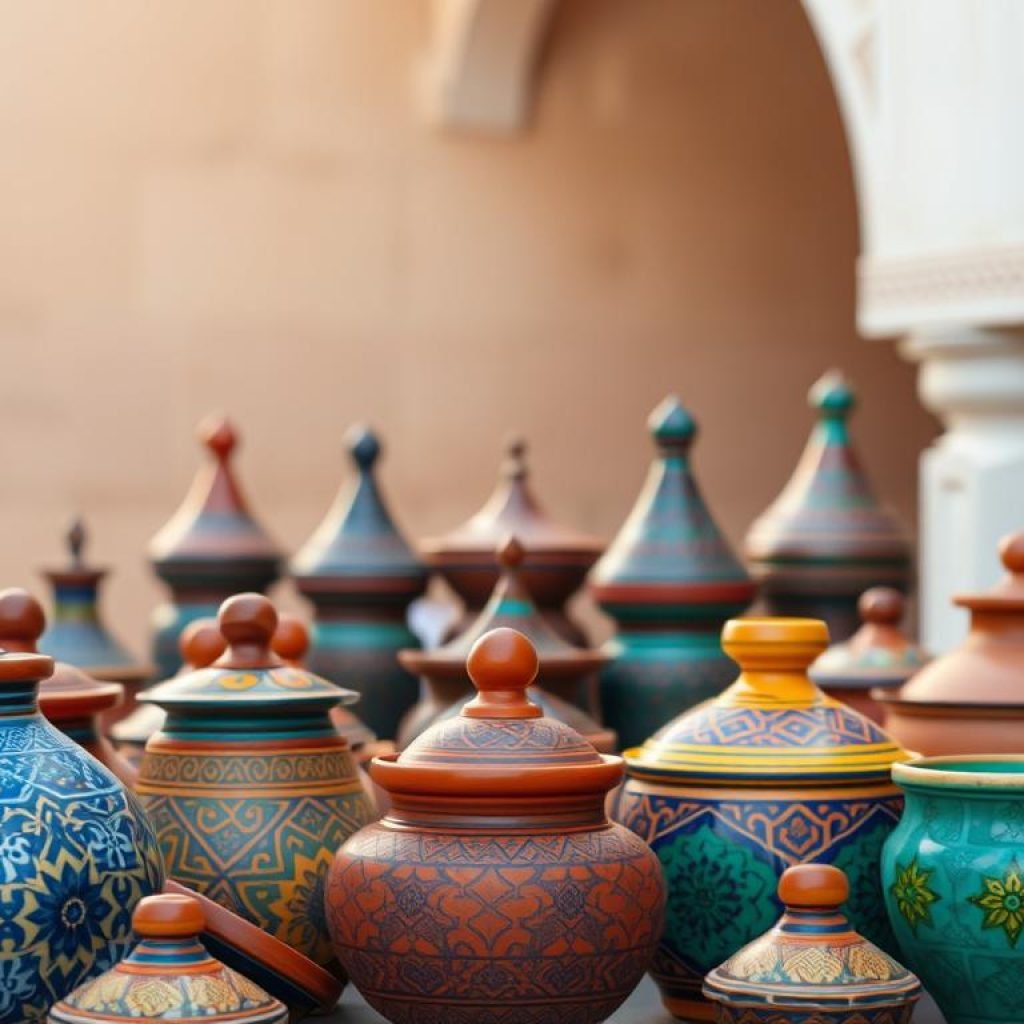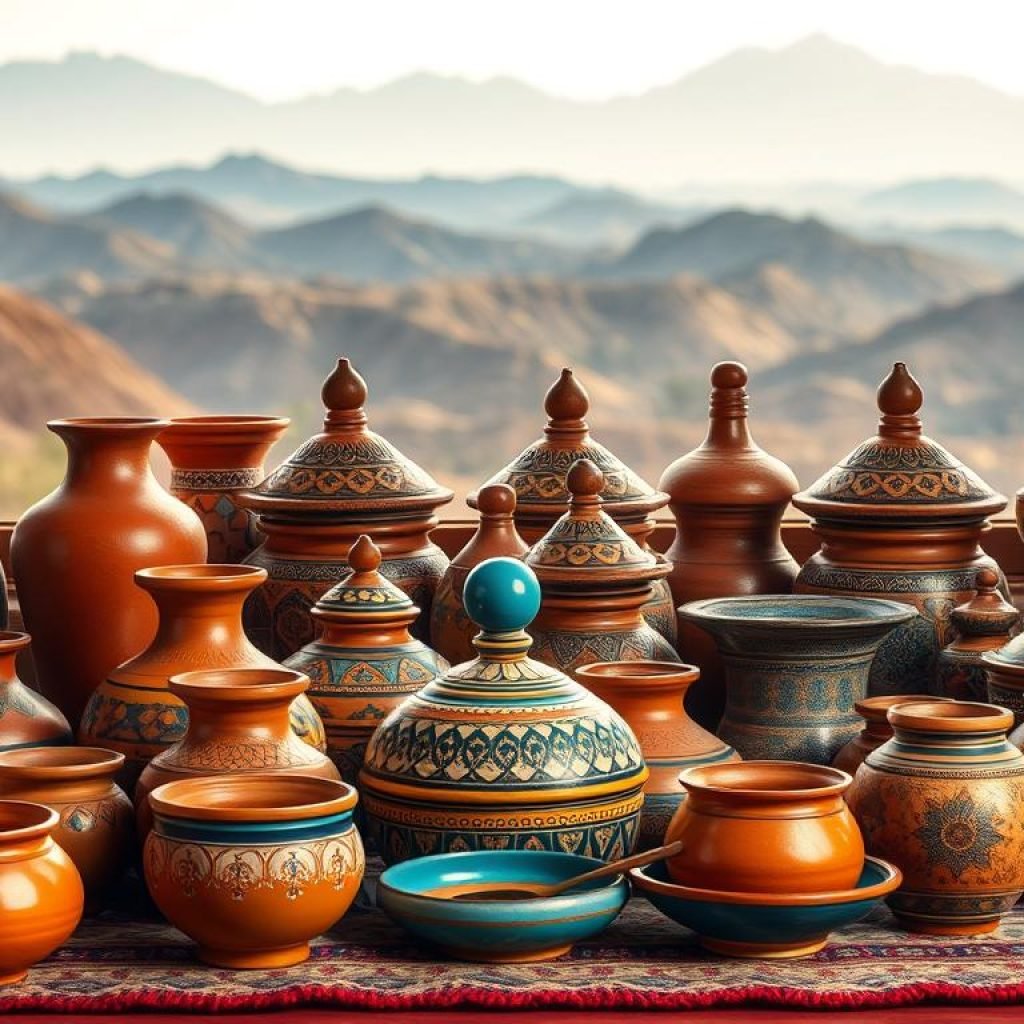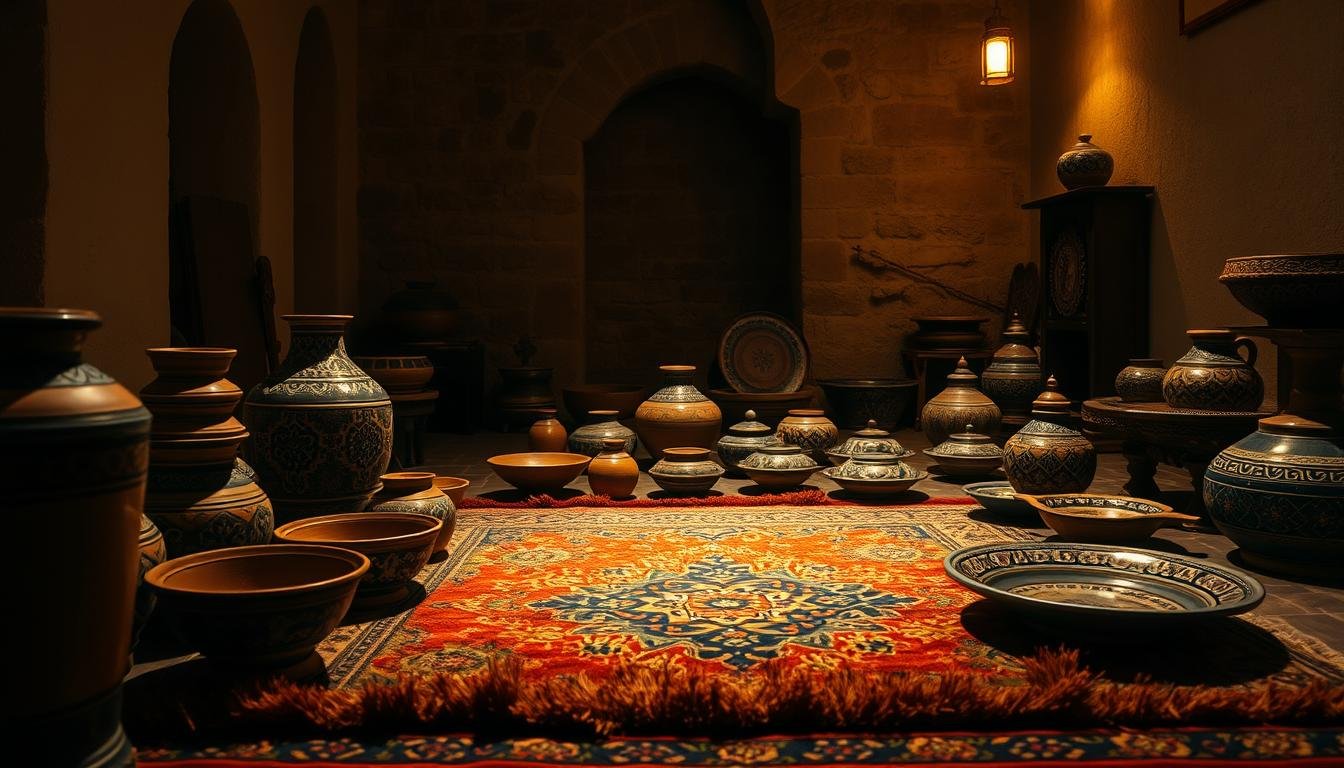Islam deeply influences the daily lives of Moroccans, from their pottery to cultural practices. With about 99% of the population Muslim, Islam’s impact is clear. It shapes the country’s culture and traditions, including the beautiful Moroccan pottery.
In Moroccan culture, Islamic art and architecture stand out. They are known for intricate designs, calligraphy, and geometric patterns. These reflect Morocco’s cultural heritage. The influence of Islam is also seen in Moroccan cuisine, music, and social customs. This blend of Arab, Berber, and African cultures is often showcased in traditional design and handmade ceramics, like Moroccan pottery.
Traditional Moroccan craftsmanship is still highly valued. From preparing the clay to glazing, artisans create unique, authentic pieces. These pieces reflect Morocco’s rich cultural heritage and traditional design.
Key Takeaways
- Moroccan pottery is a centuries-old tradition celebrated for its intricate patterns and vibrant glazes, often featuring traditional design and handmade ceramics.
- Islam plays a significant role in shaping the daily lives of Moroccans, influencing their cultural practices and traditions, including the creation of Moroccan pottery.
- Traditional Moroccan craftsmanship is still highly valued, with many artisans creating unique and authentic pieces of handmade ceramics, such as Moroccan pottery.
- Moroccan culture is a blend of Arab, Berber, and African cultural elements, reflecting the country’s rich cultural heritage and traditional design.
- Islamic art and architecture are prominent in Morocco, characterized by intricate designs, calligraphy, and geometric patterns, often featured in Moroccan pottery and other traditional crafts.
Overview of Moroccan Pottery
Moroccan pottery is famous for its authentic clayware and artisanal crafts. These have been shaped by the country’s rich culture and location. The craft has a long history, dating back to the Neolithic era.
Over time, Moroccan pottery has evolved. It has been influenced by various cultures, including the Moors and the Spanish.
The production of Moroccan pottery is influenced by both Moorish and Spanish cultures. This results in a unique blend of North African art and craftsmanship. Artists like Mohammed Langassi and Boujmaa el Lamali have made Moroccan pottery famous since the 19th century.
The main centers for ceramics in Morocco are Safi and Fez. Safi pottery is known for its yellow clay and black lines. It is overglazed with a greenish-blue color.
- Intricate hand-painted ceramics with designs that have been maintained for over 200 years by some tribes
- Use of cobalt oxide to produce a range of blue shades
- Floral and geometric designs available in cobalt blue and multicolored variations
The mix of traditional techniques and modern influences has made Moroccan pottery vibrant and diverse. It is a key part of the North African art scene. Moroccan pottery’s authentic clayware and artisanal crafts continue to inspire artists. They ensure the craft’s preservation for future generations.
Islamic Practices in Daily Routine
Moroccan daily life is deeply influenced by Islamic practices. About 99% of Moroccans practice Sunni Islam. The call to prayer happens five times a day, reminding Muslims of their daily prayers, known as Salah.
This practice is a cornerstone of Islamic faith. Its impact can be seen in various aspects of Moroccan culture. This includes decorative home accents and collectible ceramics.
In addition to daily prayers, Ramadan observance is another significant Islamic practice in Morocco. During Ramadan, Muslims fast from dawn to sunset. This impacts daily routines and social interactions.
This period is also a time for spiritual reflection and renewal. Many Moroccans focus on their faith and community during Ramadan. The unique pottery styles and ceramics produced during this time often reflect the spiritual and cultural significance of Ramadan.

Another important Islamic practice in Morocco is Zakat, or charity. This practice involves giving to those in need. It is considered one of the five pillars of Islam.
In Morocco, Zakat is often practiced through communal dining and the sharing of meals. This is especially true during Ramadan. This emphasis on community and hospitality is reflected in the country’s rich cultural heritage.
This is seen in its decorative home accents and collectible ceramics. These often feature intricate designs and patterns inspired by Islamic art.
Islamic Values Shaping Moroccan Culture
Moroccan culture is deeply rooted in Islamic values. These values greatly influence the country’s traditions, customs, and crafts. Handmade ceramics are a prime example, showcasing Morocco’s traditional design and authentic clayware.
The art of Moroccan pottery is more than just creating beautiful pieces. It’s about keeping the country’s cultural heritage alive. Moroccan pottery has a long history, shaped by cultures like the Phoenicians, Romans, and Berbers.
Moroccan pottery is known for vibrant colors, intricate patterns, and traditional symbols. Symbols like the hand of Fatima and the eight-pointed star are common. They represent protection, spirituality, and prosperity, often found in handmade ceramics and authentic clayware.
Hospitality and Community
In Moroccan culture, hospitality and community are highly valued. This is seen in the traditional design of Moroccan pottery. Pottery-making is often a communal activity, with artisans working together to create beautiful pieces.
Respect for Elders
Respect for elders is a key value in Moroccan culture. This is reflected in the passing down of pottery-making techniques from generation to generation. Young artisans learn from experienced masters through apprenticeships.
By preserving these traditional techniques and values, Moroccan pottery remains a vital part of the country’s cultural heritage. Its beauty and significance are enjoyed by people worldwide.
The Impact of Islamic Holidays
Islamic holidays deeply influence Moroccan culture, especially in artisanal crafts. The country’s rich North African art is seen in the decorations during these times. Eid al-Fitr and Eid al-Adha are key holidays that shape the crafts industry.
During these holidays, Moroccan artisans make stunning decorative art. This includes detailed ceramics and textiles. These items are not just beautiful but also show the country’s cultural heritage.

Some notable features of Moroccan crafts during these holidays include:
* Intricate ceramics with geometric and floral designs
* Hand-woven textiles with vibrant colors and tribal patterns
* Beautiful metalwork, like lanterns and decorative pieces
These items are highly valued for their beauty and cultural importance. They are crucial to the country’s crafts industry.
Women and Islam in Morocco
Moroccan women are key in keeping the country’s rich culture alive, especially in pottery. They pass down their pottery skills to the next generation. Women are also valued for their roles in family and religious life.
The beauty of Moroccan ceramics shows the country’s Islamic roots. Each piece, with its patterns and colors, shares a part of Morocco’s story. Women play a big role in making these pieces and keeping traditional methods alive.
Moroccan women are also known for their pottery skills. They use natural materials and old techniques to make each piece special. Whether it’s a vase or a cooking pot, their work shows Morocco’s cultural depth and women’s important role in it.
Youth and Religion in Morocco
In Morocco, young people face a big challenge. They must balance modern life with traditional values. This is seen in the preservation of authentic clayware and artisanal crafts, key parts of North African art. Moroccan youth must find a way to connect with their cultural heritage while also embracing new influences.
Young Moroccans are finding ways to engage with their culture. Many are involved in making authentic clayware and artisanal crafts. This helps keep the country’s rich cultural heritage alive. By doing this, they connect with their roots and help keep North African art alive.
Visitors can explore Morocco’s vibrant culture by visiting local markets and shops. They can find unique authentic clayware and artisanal crafts there. They can also check out the website experience Morocco like a local to learn about the country’s customs and traditions.
Young people in Morocco are engaging with their cultural heritage in many ways. They include:
- Participating in traditional music and dance performances
- Creating authentic clayware and artisanal crafts
- Learning about the history and significance of North African art
The Relationship Between Islam and Education
In Morocco, education is key to the country’s culture and faith. The government puts 20% of its budget into schools. This shows how much they value learning and growing intellectually.
The country’s rich culture is seen in its pottery, home decor, and ceramics. Islamic studies are a big part of school. This includes learning from the Quran and Hadith.
This learning affects Moroccan pottery. Artisans use Islamic patterns in their work. This creates a special pottery style that shows the country’s culture and faith.
- Intricate geometric patterns and motifs inspired by Islamic art
- Vibrant colors and glazes that reflect the country’s rich cultural heritage
- Unique shapes and forms that blend traditional and modern styles
Moroccan pottery is very popular among collectors. People love its unique designs and colors. It’s a way to show off the country’s culture and faith through art.
The Influence of Islam on Moroccan Cuisine
Moroccan cuisine is a mix of cultures, with Islam being a big part. It uses handmade ceramics and authentic clayware a lot. These items are key in making and serving traditional dishes.
The tagine dish is a great example of Islam’s impact. It’s cooked in earthenware pots. These pots have traditional design like geometric patterns. They show Morocco’s rich culture and art.
Some key things about Moroccan cuisine are:
- It uses halal meat and ingredients.
- It focuses on community and socializing during meals.
- It uses special spices like cumin, saffron, and mint.
Moroccan food is not just tasty but also beautiful. The handmade ceramics and authentic clayware make it look great. This mix of old and new makes Moroccan food unique and colorful.
| Traditional Moroccan Dishes | Ingredients | Cooking Method |
|---|---|---|
| Tagine | Meat, vegetables, spices | Slow-cooked in a clay pot |
| Couscous | Meat, vegetables, spices | Steamed over boiling water |
Islam’s influence on Moroccan food is clear. It values community, hospitality, and tradition. The use of handmade ceramics and authentic clayware shows Morocco’s deep cultural roots and its dedication to keeping traditions alive.
Conclusion: The Future of Islam in Morocco
Morocco’s society is changing, and Islam’s role is a balance. The country’s crafts, art, and pottery show Islamic values and heritage. These traditions are important and lasting.
Moroccan potters mix old techniques with new designs. They make pieces that honor the nation’s history and appeal to today’s viewers. From Fes’s blue and white ceramics to Safi’s colorful ones, each style shows the mix of tradition and innovation.
Morocco faces modern challenges, but keeping traditional crafts is key. It helps keep the country’s culture and Islam’s impact alive. Supporting Moroccan artisans ensures Islam’s influence in Morocco remains a source of pride and a link to the past.




Comment (0)